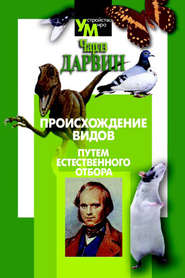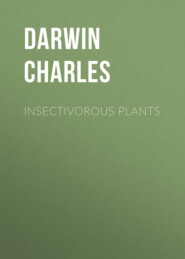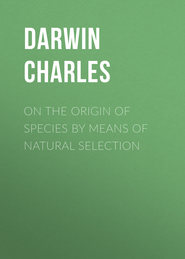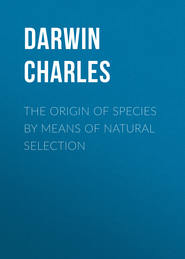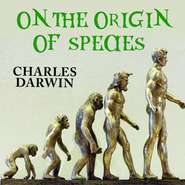По всем вопросам обращайтесь на: info@litportal.ru
(©) 2003-2024.
✖
More Letters of Charles Darwin — Volume 1
Настройки чтения
Размер шрифта
Высота строк
Поля
I saw your nice notice of poor Forbes in the "Gardeners' Chronicle," and I see in the "Athenaeum" a notice of meeting on last Saturday of his friends. Of course I shall wish to subscribe as soon as possible to any memorial...
I have just been testing practically what disuse does in reducing parts. I have made {skeletons} of wild and tame duck (oh the smell of well-boiled, high duck!), and I find the tame duck ought, according to scale of wild prototype, to have its two wings 360 grains in weight; but it has only 317, or 43 grains too little, or 1/7 of {its} own two wings too little in weight. This seems rather interesting to me. (43/2. On the conclusions drawn from these researches, see Mr. Platt Ball, "The Effects of Use and Disuse" (Nature Series), 1890, page 55. With regard to his pigeons, Darwin wrote, in November 1855: "I love them to that extent that I cannot bear to kill and skeletonise them.")
P.S. — I do not know whether you will think this worth reading over. I have worked it out since writing my letter, and tabulate the whole.
21 orders with 1 genus, having 7.95 species (or 4.6?).
29 orders with 2 genera, having 15.05 species on an average.
23 orders each with 3 genera, and these genera include on an average 8.2 species.
20 orders each with 4 genera, and these genera include on an average 12.2 species.
27 orders each with above 50 genera (altogether 4716 genera), and these genera on an average have 9.97 species.
From this I conclude, whether there be many or few genera in an order, the number of species in a genus is not much affected; but perhaps when {there is} only one genus in an order it will be affected, and this will depend whether the {genus} Erythroxylon be made a family of.
LETTER 44. TO J.D. HOOKER. Down, April 8th {1856}.
I have been particularly glad to get your splendid eloge of Lindley. His name had been lately passing through my head, and I had hoped that Miers would have proposed him for the Royal medal. I most entirely agree that the Copley (44/1. The late Professor Lindley never attained the honour of the Copley medal. The Royal medal was awarded to him in 1857.) is more appropriate, and I daresay he would not have valued the Royal. From skimming through many botanical books, and from often consulting the "Vegetable Kingdom," I had (ignorant as I am) formed the highest opinion of his claims as a botanist. If Sharpey will stick up strong for him, we should have some chance; but the natural sciences are but feebly represented in the Council. Sir P. Egerton, I daresay, would be strong for him. You know Bell is out. Now, my only doubt is, and I hope that you will consider this, that the natural sciences being weak on the Council, and (I fancy) the most powerful man in the Council, Col. S{abine}, being strong against Lindley, whether we should have any chance of succeeding. It would be so easy to name some eminent man whose name would be well-known to all the physicists. Would Lindley hear of and dislike being proposed for the Copley and not succeeding? Would it not be better on this view to propose him for the Royal? Do think of this. Moreover, if Lindley is not proposed for the Royal, I fear both Royal medals would go {to} physicists; for I, for one, should not like to propose another zoologist, though Hancock would be a very good man, and I fancy there would be a feeling against medals to two botanists. But for whatever Lindley is proposed, I will do my best. We will talk this over here.
LETTER 45. TO J.D. HOOKER. Down, May 9th {1856}.
...With respect to Huxley, I was on the point of speaking to Crawford and Strezlecki (who will be on Committee of the Athenaeum) when I bethought me of how Owen would look and what he would say. Cannot you fancy him, with slow and gentle voice, asking "Will Mr. Crawford tell me what Mr. Huxley has done, deserving this honour; I only know that he differs from, and disputes the authority of Cuvier, Ehrenberg, and Agassiz as of no weight at all." And when I began to tell Mr. Crawford what to say, I was puzzled, and could refer him only to some excellent papers in the "Phil. Trans." for which the medal had been awarded. But I doubt, with an opposing faction, whether this would be considered enough, for I believe real scientific merit is not thought enough, without the person is generally well known. Now I want to hear what you deliberately think on this head: it would be bad to get him proposed and then rejected; and Owen is very powerful.
LETTER 46. TO J.D. HOOKER. Down {1856}.
I have got the Lectures, and have read them. (46/1. The reference is presumably to the Royal Institution Lectures given in 1854-56. Those which we have seen — namely, those reprinted in the "Scientific Memoirs," Volume I. — "On the Common Plan of Animal Form," page 281; "On certain Zoological Arguments, etc." page 300; "On Natural History as Knowledge, Discipline, and Power," page 305, do not seem to us to contain anything likely to offend; but Falconer's attack in the "Ann. and Mag. of Nat. Hist." June 1856, on the last-named lecture, shows strong feeling. A reply by Mr. Huxley appeared in the July number of the same Journal. The most heretical discussion from a modern standpoint is at page 311, where he asks how it is conceivable that the bright colours of butterflies and shells or the elegant forms of Foraminifera can possibly be of service to their possessors; and it is this which especially struck Darwin, judging by the pencil notes on his copy of the Lecture.) Though I believe, as far as my knowledge goes, that Huxley is right, yet I think his tone very much too vehement, and I have ventured to say so in a note to Huxley. I had not thought of these lectures in relation to the Athenaeum (46/2. Mr. Huxley was in 1858 elected to the Athenaeum Club under Rule 2, which provides for the annual election of "a certain number of persons of distinguished eminence in science, literature, or the arts, or for public services."), but I am inclined quite to agree with you, and that we had better pause before anything is said...(N.B. I found Falconer very indignant at the manner in which Huxley treated Cuvier in his Royal Institution lectures; and I have gently told Huxley so.) I think we had better do nothing: to try in earnest to get a great naturalist into the Athenaeum and fail, is far worse than doing nothing.
How strange, funny, and disgraceful that nearly all (Faraday and Sir J. Herschel at least exceptions) our great men are in quarrels in couplets; it never struck me before...
LETTER 47. C. LYELL TO CHARLES DARWIN.
(47/1. In the "Life and Letters," II., page 72, is given a letter (June 16th, 1856) to Lyell, in which Darwin exhales his indignation over the "extensionists" who created continents ad libitum to suit the convenience of their theories. On page 74 a fuller statement of his views is given in a letter dated June 25th. We have not seen Lyell's reply to this, but his reply to Darwin's letter of June 16th is extant, and is here printed for the first time.)
53, Harley Street, London, June 17th, 1856.
I wonder you did not also mention D. Sharpe's paper (47/2. "On the Last Elevation of the Alps, etc." ("Quart. Journ. Geol. Soc." Volume XII., 1856, page 102.), just published, by which the Alps were submerged as far as 9,000 feet of their present elevation above the sea in the Glacial period and then since uplifted again. Without admitting this, you would probably convey the alpine boulders to the Jura by marine currents, and if so, make the Alps and Jura islands in the glacial sea. And would not the Glacial theory, as now very generally understood, immerse as much of Europe as I did in my original map of Europe, when I simply expressed all the area which at some time or other had been under water since the commencement of the Eocene period? I almost suspect the glacial submergence would exceed it.
But would not this be a measure of the movement in every other area, northern (arctic), antarctic, or tropical, during an equal period — oceanic or continental? For the conversion of sea into land would always equal the turning of much land into sea.
But all this would be done in a fraction of the Pliocene period; the Glacial shells are barely 1 per cent. extinct species. Multiply this by the older Pliocene and Miocene epochs.
You also forget an author who, by means of atolls, contrived to submerge archipelagoes (or continents?), the mountains of which must originally have differed from each other in height 8,000 (or 10,000?) feet, so that they all just rose to the surface at one level, or their sites are marked by buoys of coral. I could never feel sure whether he meant this tremendous catastrophe, all brought about by what Sedgwick called "Lyell's niggling operations," to have been effected during the era of existing species of corals. Perhaps you can tell me, for I am really curious to know...(47/3. The author referred to is of course Darwin.)
Now, although there is nothing in my works to warrant the building up of continents in the Atlantic and Pacific even since the Eocene period, yet, as some of the rocks in the central Alps are in part Eocene, I begin to think that all continents and oceans may be chiefly, if not all, post-Eocene, and Dana's "Atlantic Ocean" of the Lower Silurian is childish (see the Anniversary Address, 1856). (47/4. Probably Dana's Anniversary Address to the "American Association for the Advancement of Science," published in the "Proceedings" 1856.) But how far you are at liberty to call up continents from "the vasty deep" as often as you want to convey a Helix from the United States to Europe in Miocene or Pliocene periods is a question; for the ocean is getting deeper of late, and Haughton says the mean depth is eleven miles! by his late paper on tides. (47/5. "On the Depth of the Sea deducible from Tidal Observations" ("Proc. Irish Acad." Volume VI., page 354, 1853-54).) I shall be surprised if this turns out true by soundings.
I thought your mind was expanding so much in regard to time that you would have been going ahead in regard to the possibility of mountain-chains being created in a fraction of the period required to convert a swan into a goose, or vice versa. Nine feet did the Rimutaka chain of New Zealand gain in height in January, 1855, and a great earthquake has occurred in New Zealand every seven years for half a century nearly. The "Washingtonia" (Californian conifer) (47/6. Washingtonia, or Wellingtonia, better known as Sequoia. Asa Gray, writing in 1872, states his belief that "no Sequoia now alive can sensibly antedate the Christian era" ("Scientific Papers," II., page 144).) lately exhibited was four thousand years old, so that one individual might see a chain of hills rise, and rise with it, much {more} a species — and those islands which J. Hooker describes as covered with New Zealand plants three hundred (?) miles to the N.E. (?) of New Zealand may have been separated from the mainland two or three or four generations of Washingtonia ago.
If the identity of the land-shells of all the hundreds of British Isles be owing to their having been united since the Glacial period, and the discordance, almost total, of the shells of Porto Santo and Madeira be owing to their having been separated {during} all the newer and possibly older Pliocene periods, then it gives us a conception of time which will aid you much in your conversion of species, if immensity of time will do all you require; for the Glacial period is thus shown, as we might have anticipated, to be contemptible in duration or in distance from us, as compared to the older Pliocene, let alone the Miocene, when our contemporary species were, though in a minority, already beginning to flourish.
The littoral shells, according to MacAndrew, imply that Madeira and the Canaries were once joined to the mainland of Europe or Africa, but that those isles were disjoined so long ago that most of the species came in since. In short, the marine shells tell the same story as the land shells. Why do the plants of Porto Santo and Madeira agree so nearly? And why do the shells which are the same as European or African species remain quite unaltered, like the Crag species, which returned unchanged to the British seas after being expelled from them by glacial cold, when two millions (?) of years had elapsed, and after such migration to milder seas? Be so good as to explain all this in your next letter.
LETTER 48. TO J.D. HOOKER. Down, July 5th {1856}.
I write this morning in great tribulation about Tristan d'Acunha. (48/1. See "Flora Antarctica," page 216. Though Tristan d'Acunha is "only 1,000 miles distant from the Cape of Good Hope, and 3,000 from the Strait of Magalhaens, the botany of this island is far more intimately allied to that of Fuegia than Africa.") The more I reflect on your Antarctic flora the more I am astounded. You give all the facts so clearly and fully, that it is impossible to help speculating on the subject; but it drives me to despair, for I cannot gulp down your continent; and not being able to do so gives, in my eyes, the multiple creationists an awful triumph. It is a wondrous case, and how strange that A. De Candolle should have ignored it; which he certainly has, as it seems to me. I wrote Lyell a long geological letter (48/2. "Life and Letters," II., page 74.) about continents, and I have had a very long and interesting answer; but I cannot in the least gather his opinion about all your continental extensionists; and I have written again beseeching a verdict. (48/3. In the tenth edition of the "Principles," 1872, Lyell added a chapter (Chapter XLI., page 406) on insular floras and faunas in relation to the origin of species; he here (page 410) gives his reasons against Forbes as an extensionist.) I asked him to send to you my letter, for as it was well copied it would not be troublesome to read; but whether worth reading I really do not know; I have given in it the reasons which make me strongly opposed to continental extensions.
I was very glad to get your note some days ago: I wish you would think it worth while, as you intend to have the Laburnum case translated, to write to "Wien" (that unknown place) (48/4. There is a tradition that Darwin once asked Hooker where "this place Wien is, where they publish so many books."), and find out how the Laburnum has been behaving: it really ought to be known.
The Entada is a beast. (48/5. The large seeds of Entada scandens are occasionally floated across the Atlantic and cast on the shores of Europe.); I have never differed from you about the growth of a plant in a new island being a FAR harder trial than transportal, though certainly that seems hard enough. Indeed I suspect I go even further than you in this respect; but it is too long a story.
Thank you for the Aristolochia and Viscum cases: what species were they? I ask, because oddly these two very genera I have seen advanced as instances (I forget at present by whom, but by good men) in which the agency of insects was absolutely necessary for impregnation. In our British dioecious Viscum I suppose it must be necessary. Was there anything to show that the stigma was ready for pollen in these two cases? for it seems that there are many cases in which pollen is shed long before the stigma is ready. As in our Viscum, insects carry, sufficiently regularly for impregnation, pollen from flower to flower, I should think that there must be occasional crosses even in an hermaphrodite Viscum. I have never heard of bees and butterflies, only moths, producing fertile eggs without copulation.
With respect to the Ray Society, I profited so enormously by its publishing my Cirrepedia, that I cannot quite agree with you on confining it to translations; I know not how else I could possibly have published.
I have just sent in my name for 20 pounds to the Linnaean Society, but I must confess I have done it with heavy groans, whereas I daresay you gave your 20 pounds like a light-hearted gentleman...
P.S. Wollaston speaks strongly about the intermediate grade between two varieties in insects and mollusca being often rarer than the two varieties themselves. This is obviously very important for me, and not easy to explain. I believe I have had cases from you. But, if you believe in this, I wish you would give me a sentence to quote from you on this head. There must, I think, be a good deal of truth in it; otherwise there could hardly be nearly distinct varieties under any species, for we should have instead a blending series, as in brambles and willows.
LETTER 49. TO J.D. HOOKER. July 13th, 1856.
What a book a devil's chaplain might write on the clumsy, wasteful, blundering, low, and horribly cruel works of nature! With respect to crossing, from one sentence in your letter I think you misunderstand me. I am very far from believing in hybrids: only in crossing of the same species or of close varieties. These two or three last days I have been observing wheat, and have convinced myself that L. Deslongchamps is in error about impregnation taking place in closed flowers; i.e., of course, I can judge only from external appearances. By the way, R. Brown once told me that the use of the brush on stigma of grasses was unknown. Do you know its use?..
You say most truly about multiple creations and my notions. If any one case could be proved, I should be smashed; but as I am writing my book, I try to take as much pains as possible to give the strongest cases opposed to me, and often such conjectures as occur to me. I have been working your books as the richest (and vilest) mine against me; and what hard work I have had to get up your New Zealand Flora! As I have to quote you so often, I should like to refer to Muller's case of the Australian Alps. Where is it published? Is it a book? A correct reference would be enough for me, though it is wrong even to quote without looking oneself. I should like to see very much Forbes's sheets, which you refer to; but I must confess (I hardly know why) I have got rather to mistrust poor dear Forbes.
There is wonderful ill logic in his famous and admirable memoir on distribution, as it appears to me, now that I have got it up so as to give the heads in a page. Depend on it, my saying is a true one — viz. that a compiler is a great man, and an original man a commonplace man. Any fool can generalise and speculate; but oh, my heavens, to get up at second hand a New Zealand Flora, that is work...
And now I am going to beg almost as great a favour as a man can beg of another: and I ask some five or six weeks before I want the favour done, that it may appear less horrid. It is to read, but well copied out, my pages (about forty!!) on Alpine floras and faunas, Arctic and Antarctic floras and faunas, and the supposed cold mundane period. It would be really an enormous advantage to me, as I am sure otherwise to make botanical blunders. I would specify the few points on which I most want your advice. But it is quite likely that you may object on the ground that you might be publishing before me (I hope to publish in a year at furthest), so that it would hamper and bother you; and secondly you may object to the loss of time, for I daresay it would take an hour and a half to read. It certainly would be of immense advantage to me; but of course you must not think of doing it if it would interfere with your own work.
I do not consider this request in futuro as breaking my promise to give no more trouble for some time.
From Lyell's letters, he is coming round at a railway pace on the mutability of species, and authorises me to put some sentences on this head in my preface.
I shall meet Lyell on Wednesday at Lord Stanhope's, and will ask him to forward my letter to you; though, as my arguments have not struck him, they cannot have force, and my head must be crotchety on the subject; but the crotchets keep firmly there. I have given your opinion on continuous land, I see, too strongly.
LETTER 50. TO S.P. WOODWARD. Down, July 18th {1856}.
Very many thanks for your kindness in writing to me at such length, and I am glad to say for your sake that I do not see that I shall have to beg any further favours. What a range and what a variability in the Cyrena! (50/1. A genus of Lamellibranchs ranging from the Lias to the present day.) Your list of the ranges of the land and fresh-water shells certainly is most striking and curious, and especially as the antiquity of four of them is so clearly shown.
I have got Harvey's seaside book, and liked it; I was not particularly struck with it, but I will re-read the first and last chapters.
I am growing as bad as the worst about species, and hardly have a vestige of belief in the permanence of species left in me; and this confession will make you think very lightly of me, but I cannot help it. Such has become my honest conviction, though the difficulties and arguments against such heresy are certainly most weighty.
LETTER 51. TO C. LYELL. November 10th {1856}.
I know you like all cases of negative geological evidence being upset. I fancied that I was a most unwilling believer in negative evidence; but yet such negative evidence did seem to me so strong that in my "Fossil Lepadidae" I have stated, giving reasons, that I did not believe there could have existed any sessile cirripedes during the Secondary ages. Now, the other day Bosquet of Maestricht sends me a perfect drawing of a perfect Chthamalus (a recent genus) from the Chalk! (51/1. Chthamalus, a genus of Cirripedia. ("A Monograph on the Sub-class Cirripedia," by Charles Darwin, page 447. London, 1854.) A fossil species of this genus of Upper Cretaceous age was named by Bosquet Chthamalus Darwini. See "Origin," Edition VI., page 284; also Zittel, "Traite de Paleontologie," Traduit par Dr. C. Barrois, Volume II., page 540, figure 748. Paris, 1887.) Indeed, it is stretching a point to make it specifically distinct from our living British species. It is a genus not hitherto found in any Tertiary bed.
LETTER 52. TO T.H. HUXLEY. Down, July 9th, 1857.






